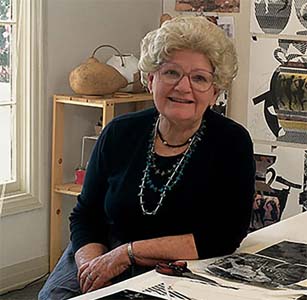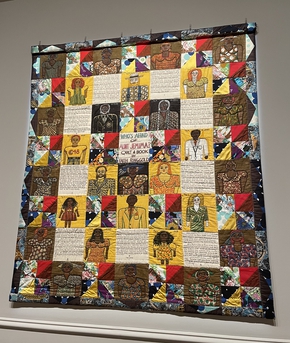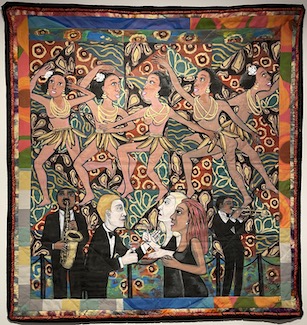
Quilting is the term given to the process of joining a minimum of three layers of fabric together either through stitching manually using a needle and thread, or mechanically with a sewing machine or specialised longarm quilting system. An array of stitches is passed through all layers of the fabric to create a three-dimensional padded surface. The three layers are typically referred to as the top fabric or quilt top, batting or insulating material, and the backing.

The Metropolitan Museum of Art, colloquially referred to as the Met, is an encyclopedic art museum in New York City. It is the largest art museum in the Americas and the fourth-largest in the world. With 5.36 million visitors in 2023, it is the most-visited museum in the United States and the fourth-most visited art museum in the world.

A quilt is a multi-layered textile, traditionally composed of two or more layers of fabric or fiber. Commonly three layers are used with a filler material. These layers traditionally include a woven cloth top, a layer of batting or wadding, and a woven back combined using the techniques of quilting. This is the process of sewing on the face of the fabric, and not just the edges, to combine the three layers together to reinforce the material. Stitching patterns can be a decorative element. A single piece of fabric can be used for the top of a quilt, but in many cases the top is created from smaller fabric pieces joined, or patchwork. The pattern and color of these pieces creates the design.

African-American art is a broad term describing visual art created by African Americans. The range of art they have created, and are continuing to create, over more than two centuries is as varied as the artists themselves. Some have drawn on cultural traditions in Africa, and other parts of the world, for inspiration. Others have found inspiration in traditional African-American plastic art forms, including basket weaving, pottery, quilting, woodcarving and painting, all of which are sometimes classified as "handicrafts" or "folk art".

Faith Ringgold was an American painter, author, mixed media sculptor, performance artist, and intersectional activist, perhaps best known for her narrative quilts.
The Berkeley Art Museum and Pacific Film Archive are a combined art museum, repertory movie theater, and archive associated with the University of California, Berkeley. Lawrence Rinder was Director from 2008, succeeded by Julie Rodrigues Widholm in August, 2020. The museum is a member of the North American Reciprocal Museums program.
Michael Francis James is an American artist, educator, author, and lecturer. He is best known as a leader of the art quilt movement that began in the 1970s. He currently lives and maintains a studio in Lincoln, Nebraska.

Katherine Westphal was an American textile designer and fiber artist who helped to establish quilting as a fine art form.

Dindga McCannon is an African-American artist, fiber artist, muralist, teacher author and illustrator. She co-founded the collective Where We At, Black Women Artists in 1971.

Delirious Hem is a 1995 painting by Ellen Gallagher. It is in the collection of the Metropolitan Museum of Art in New York, New York in the United States.

Mother and Child (The Oval Mirror) is an oil-on-canvas painting by the American Impressionist artist Mary Cassatt. The painting depicts a mother and her child in front of a mirror. The painting provides a glimpse of the domestic life of a mother and her child, evoking religious iconography from the Italian Renaissance. However, portrayals of a mother and her child are common in Cassatt's work, so it is possible that this similarity is coincidental rather than intentional.

Lisa Farrington is an American art historian, specializing in African-American art, Haitian art, and women's art. She is a Distinguished Professor in the Department of Art and Music at the John Jay College of Criminal Justice. Farrington is one of the major scholars of Faith Ringgold, is the author of several books on African-American art, and is one of only six full professors of African-American art history in the United States.

Christ Carrying the Cross is an oil painting by El Greco, produced early in his Toledo period circa de 1580. The picture depicts Christ in a moment of personal reflection as he carries the cross to his death, therefore committing the ultimate sacrifice for humankind. In the painting, Christ's eyes are lifted up to the heavens as he begins his walk towards his crucifixion. His gentle hands wrap around the cross as a stormy night floods the background. Christ Carrying the Cross is an oil painting, 105x79cm. The painting, one of numerous similar paintings by El Greco, is currently in the El Greco room in the New York art collection of the Metropolitan Museum of Art.
Bisa Butler is an American fiber artist who has created a new genre of quilting that has transformed the medium. Although quilting has long been considered a craft, her interdisciplinary methods—which create quilts that look like paintings—have catapulted quilting into the field of fine art. She is known for her vibrant, quilted portraits celebrating Black life, portraying both everyday people and notable historical figures. Her works now count among the permanent collections at the Smithsonian National Museum of African American History and Culture, the Art Institute of Chicago, Pérez Art Museum Miami and about a dozen other art museums nationwide. She has also exhibited at the Smithsonian Museum of American History, the Epcot Center, the National Underground Railroad Freedom Center, and many other venues. In 2020, she was commissioned to quilt cover images for Time magazine, including the "Person of the Year" issue and its "100 Women of the Year" issue. With a multi-year wait list for private commissions, one of Butler's quilts sold at auction in 2021 for $75,000 USD.
Pearlie Kennedy Pettway (1920–1982) was an American quilter. She was among the quilters of Gee's Bend. Her works are in the Metropolitan Museum of Art.

The American People Series #20: Die is an oil on canvas painting made by American artist Faith Ringgold in 1967. Inspired by Pablo Picasso's painting Guernica (1937) and painted amidst the riots and uprisings of the 1960s, Die is a two-panel work depicting a group of Black and white men, women, and children, most of whom are wounded or covered in blood, variously fighting, fleeing, or dying against an abstract grey background. The piece has been extensively cited as among Ringgold's most important and iconic artworks.

Who's Afraid of Aunt Jemima? is an acrylic on canvas narrative quilt made by American artist Faith Ringgold in 1983. Named for the Edward Albee play Who's Afraid of Virginia Woolf? and the character Aunt Jemima, the work is Ringgold's first story quilt and marks the early stages of the artist's shift from oil painting to quilting.

The French Collection is a series of twelve quilt paintings by American artist Faith Ringgold completed between 1991 and 1997. Divided into two parts composed of eight and four quilts each, the series utilizes Ringgold's distinct style of story quilts to tell the fictional story of a young African American woman in the 1920s, Willia Marie Simone, who leaves Harlem for Paris to live as an artist and model. The stories, illustrated in acrylic paint and written in ink surrounding the paintings, narrate Willia Marie's journey as she befriends famous artists, performers, writers, and activists, runs a café and works as a painter, and develops a distinct Black feminist intellectual worldview based on her experiences and identity. Willia Marie's interactions with notable modernist artists and their oeuvres are an archetypical example of Ringgold's responses to the predominantly white male artistic canon, wherein she often directly invoked, embraced, and challenged the central figures of modernist art.

The American Collection is a series of eleven quilt paintings by American artist Faith Ringgold, completed in 1997, with an additional unfinished quilt that the artist sketched but did not complete. The series serves as a continuation of the narrative the artist began in her earlier series of quilt paintings The French Collection (1991-1997). While the quilts in The French Collection included detailed narratives written in text along the edges of each quilt, The American Collection quilts do not include stories in text and are meant to be understood as paintings by Marlena Simone, the daughter of the fictional central character from the earlier series.















